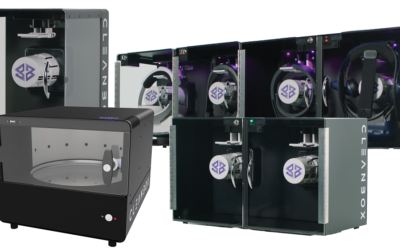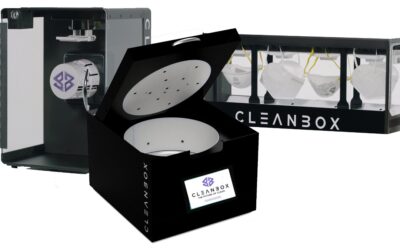As the North American International Auto Show rolls back into Detroit for the first time since 2019, automakers and attendees are as concerned with hygiene protocol as they are with automotive technology. The virtual and augmented reality headsets that allow consumers to have an immersive experience require hospital-grade sanitation to maintain user safety. Cleanbox ultraviolet light boxes provide a waste-free hygiene solution.
The Detroit Auto Show is Coming! And a Note on the Importance of Hygiene for VR/AR Solutions
The Detroit Auto Show was postponed in 2019 and 2020 due to the coronavirus pandemic. Attendees and manufacturers have been greatly anticipating the show’s return, although many individuals remain concerned about the potential for virus transmission. With the Detroit Auto Show pulling in consumers, journalists, and manufacturers from across the globe, care must be taken to prevent the spread of communicable diseases.
The futuristic technology that allows participants to test drive vehicle prototypes through VR and AR headsets poses a health challenge in a post-pandemic society. Contagions can easily cling to the surface of equipment unless precautions are taken. In 2019, nearly 780,000 attendees flocked to the Detroit Auto Show to peruse the newest automotive offerings. If this year’s attendance is similar, presenters will struggle to clean VR and AR equipment between users.
Hygiene Solutions for AR/VR Devices
Traditional sanitizing methods, such as wipes or chemical cleaning agents fail to provide a verifiable, efficient clean. In addition, testing has shown that other methods for cleaning AR and VR equipment are obsolete and untrustworthy compared to ultraviolet light boxes.
Disposable Wipes: Unreliable and Wasteful
While alcohol and bleach-based disposable wipes benefit many industries, they do not belong in the technology sector. Modern equipment can be at risk for premature deterioration when subjected to the chemical agents in disposable wipes, especially when the equipment is being cleaned frequently.
Wipes are also ill-equipped for cleaning the small crevices on most VR headsets and are only as effective as the person using them. When a user’s health is at stake, any risk for error must be eliminated. In a rush, it’s easy to inadvertently miss parts of the headset, which exposes anyone using the poorly-cleaned headset to any pathogens left behind by the prior user.
Environmental Concerns
Wipes are also not an ecologically or economically friendly disinfection method since they are single-use products. They waste time and money and ultimately end up in a landfill, where they will remain for decades. Manufacturers who recognize the importance of eco-friendly automotive technology, such as hybrid and electric vehicles and eco-efficient tires, will find using disposable wipes to be at odds with their brand’s image.
Disinfectant Sprays: Impractical and Damaging
Disinfecting sprays are an equally poor choice for cleaning VR and AR headsets. The process of spraying and wiping a headset is time-consuming, and there is no way to tell if a device has been thoroughly cleaned. Also, when a liquid cleaning solution is used to sanitize headsets, it can easily seep into the grooves on devices, exposing the inner components to moisture.
Risk Potential
In a heavily populated environment such as auto shows, the possibility of virus transmission is too great to risk using a cleaning method that cannot be verified. Additionally, many individuals are allergic to chemicals found in mainstream cleaners. This sensitivity means any residue on a headset that comes in contact with their face could trigger an allergic response.
Finally, liquids require drying time for the cleaning component to be effective, limiting the number of attendees that can use the equipment in a given time. While this delay may seem inconsequential, it could result in consumers choosing to engage with a vendor offering a shorter wait time.
Ultraviolet Light Boxes: Alternative Hygiene Technology
Cleanbox ultraviolet sanitizing units allow presenters to sanitize equipment after every user and feel confident that 99.999% of pathogens have been removed from the item. In addition, ultraviolet light devices offer a solution to the issues presented by traditional cleaning methods. Where wipes are wasteful, slow, and unreliable, ultraviolet light units are an eco-friendly, quick, and guaranteed disinfection method.
Unlike chemical-based cleaners, UVC units use only ultraviolet light rays to eliminate contagions, and the beams are safe for use on electronic equipment, even when used repeatedly. Brands presenting innovative automotive applications and vehicle prototypes need hygiene protocols that are cutting-edge, hospital-grade, and trustworthy.
UVC Sanitization: The Science
There are three types of ultraviolet light rays: A, B, and C, none of which are visible to the human eye. Ultraviolet light types A and B occur naturally on Earth, but ultraviolet C rays (UVC) cannot permeate the ozone layer. Since UVC light doesn’t exist organically inside Earth’s atmosphere, bacteria, fungus, and viruses are vulnerable to these beams. The lack of exposure to C rays prevents the pathogens from building up a resistance to UVC light.
UVC beams can destroy the RNA or DNA material inside bacteria and viruses, but the rays must be at specific wavelengths and intensity levels. Cleanbox units like the CX series use patented UVC LED engineering, which produces the intensity necessary for contagion elimination. In addition, the units are designed to cover every part of the item being sanitized in UVC rays and maintain exposure for the appropriate time (60 seconds) to ensure 99.999% disinfection.
In Action: The CX Series
When it comes to cleaning headsets, the CX series of UVC units is a game-changer for auto shows and car dealerships. Instead of using a wasteful disposable wipe to clean each headset after use and being unable to verify if a headset is clean, presenters will have an easier option that allows them to clean multiple units at once if desired. After a headset has been used, the presenter will place the headset inside the CX unit and press the button to begin the cleaning cycle.
The cleaning process will take exactly 60 seconds, regardless of how many headsets are being disinfected. At the end of the cycle, the user will remove the sanitized headset from the unit, and attendees can use the device immediately. There is no waste, minimal wait time, and the opportunity for human error is non-existent, allowing presenters to ensure the safety of attendees.
Hassle-Free Hygiene Protocol
If a hygiene protocol is too complex, the chance of it being performed successfully is low. For example, the average individual may forget to allow a disinfectant to sit on a headset for the required time or fail to wipe every mechanical component of a headset. However, the CX series makes performing a hospital-grade cleaning effortless and has no learning curve.
Cleanbox: Maintain Hygiene Standards
This sanitizing device is well-suited to the fast-paced environment of an auto show. Since presenters and sales staff will be busy talking to consumers, having a unit that eliminates pathogens without requiring the user to perform complicated steps is necessary. Even the busiest multitasker can complete the cleaning cycle correctly and ensure every attendee has a sanitary headset to wear.
Forward-thinking automotive enterprises need a hygiene system as innovative as their products. Instead of settling for cleaning methods that can’t guarantee the safety of users, brands should choose the lab-tested, scientifically proven option. To learn how this revolutionary disinfection technology excels in the automotive sector, contact Cleanbox Technology and join the informational webinar every Monday at 10:30 CST.





